How to install a split system with your own hands?
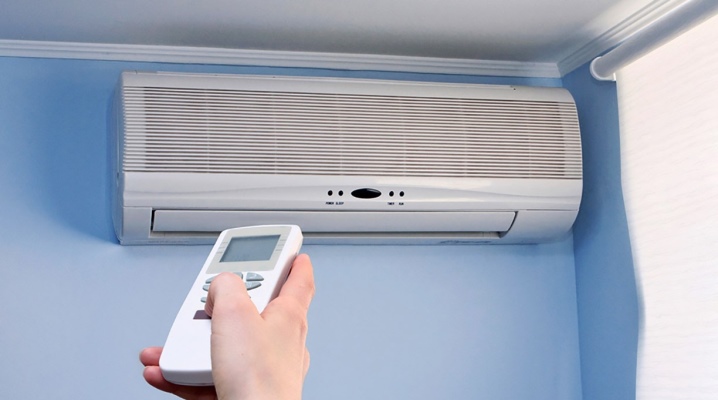
After purchasing a split system, a wizard is usually called to install it. But the services of an air conditioner installer are quite expensive. With due care and accuracy, the split system can be installed by hand.
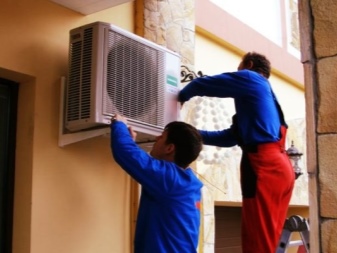
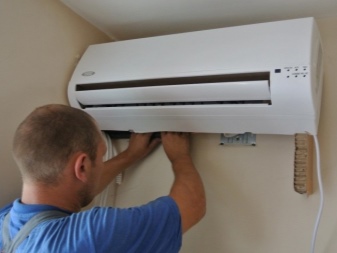
Choosing a place of installation
First of all, you should carefully consider the location of the split system parts in the apartment. Particular attention should be paid to the location of the indoor unit. The room unit will create a noticeable flow of cold air. This can be not only unpleasant, but also lead to illness. On the other hand, there is no need to blow cool air on the wall or furniture.
If you plan to install the air conditioner in the bedroom, it is better to place the fan unit above the head of the bed. In the office, it is reasonable to locate the cooling module as far from the workplace as possible.
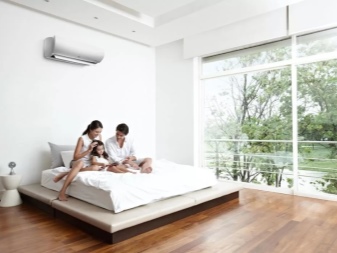
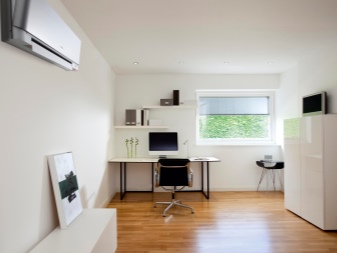
A good option would be to place it near the front door. In any case, it is necessary to provide for convenient control of the unit.

If you plan to condition the air in the kitchen, you need to make sure that the unit of this complex apparatus is as far as possible from the microwave oven and the cooking area. Microwave radiation can interfere with the electronic "stuffing" of the device, and high temperatures and fumes from cooking food will damage plastic parts.
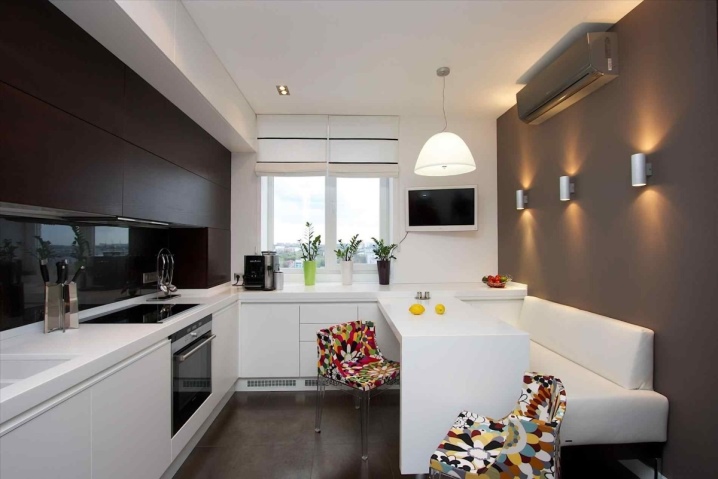
When choosing a location for the cooling module, consider the following restrictions:
- for normal air circulation, the distance from the module to the ceiling must be at least 15-18 centimeters;
- for the same reason, there should be no obstacles closer than 1.5 m in the direction of the cold air outlet;
- the side parts should not be located closer than 25 cm from the walls;
- in order for the coolness to reach its goal, you should not hang the cooler higher than 2.8 meters;
- ensure that the indoor unit and outdoor unit are approximately at the same level;
- an outdoor unit can be placed below the indoor unit, but no more than 5 meters.
When considering options for placing the unit, keep in mind that many manufacturers limit the minimum length of the connecting line. Usually the track should be no shorter than 1.5-2.5 meters. If the line is longer than 5 m, you will need to purchase additional freon.
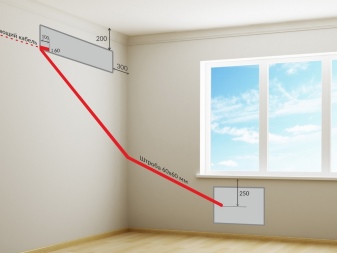

Do not forget that air conditioners consume a significant amount of electricity... There must be an electrical outlet near the control unit with a capacity of at least 2.5-4 kW. Using extension cords is not only inconvenient but also undesirable for safety reasons.

If you live in a private house, the split system can be placed in the most convenient way. It should only be taken into account that it is better to mount a heavy street block on the most durable of the walls. If necessary, it can be placed on a pedestal next to the house.
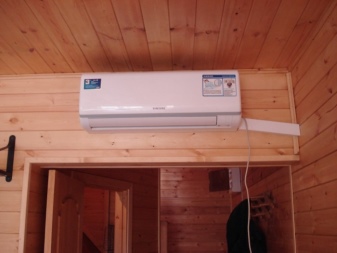
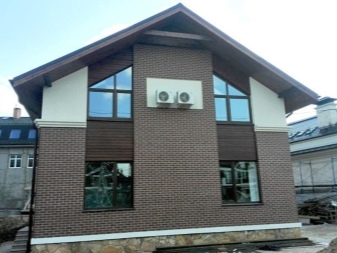
Placing a split system in an apartment building, you have to take into account the rules of cohabitation. Management companies often restrict the placement of air conditioners on an external wall. In this case, you can place the street module on a loggia or balcony.
When considering accommodation options, keep in mind that a glazed balcony is not suitable for placing an air conditioner. In this case, the system will simply overheat and will not work properly.
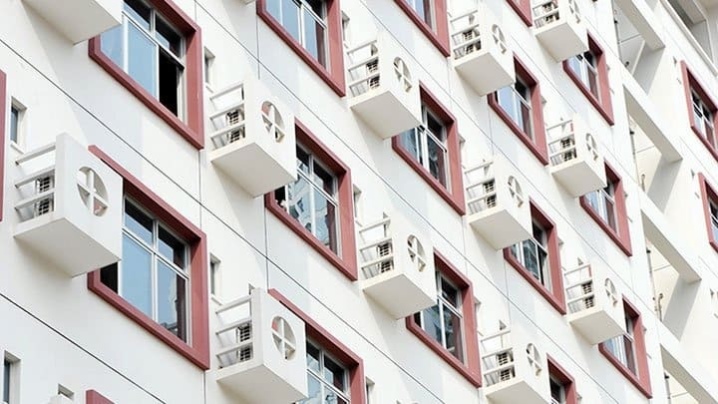
When choosing a place to install the street part of the split system, one should not forget that it may require maintenance.On the ground floor, access to the system is easier, but it can cause other problems. Place the air conditioner as far as possible from sidewalks and places where people can reach it.
Outdoor blocks of split systems have a significant weight. Therefore, they cannot be attached directly to the façade. The wall must be strong and rigid. If it is necessary to place the air conditioner on the facade, you will have to open it and fix the supporting brackets on the main wall of the building.


Required materials and tools
Materials and tools for installation must be prepared in advance. Careful planning will allow you to install the air conditioner quickly and without errors. In order to install a split system with your own hands, you will need the following materials:
- electrical wire;
- copper pipes in two sizes;
- plastic tube for drainage pipeline;
- thermal insulation for pipes;
- Scotch;
- plastic cable channel;
- metal brackets L-shaped;
- fasteners (bolts, anchors, dowels).
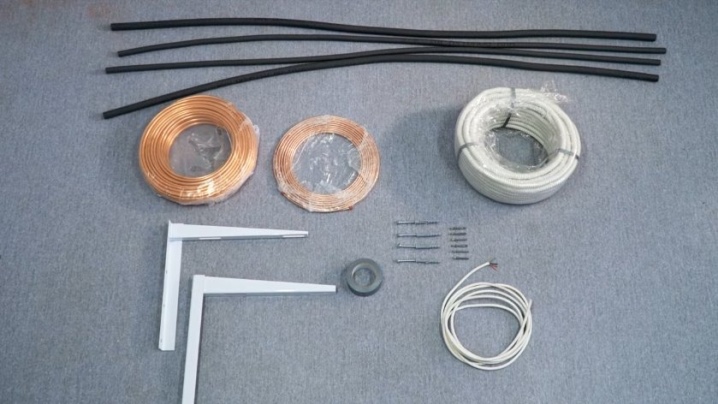
The instructions supplied with the split system indicate what electrical wires will be needed. Typically this is a 2.5 sq. mm. You should purchase a non-combustible cable, for example, brand VVGNG 4x2.5. When purchasing a cable, measure 1-1.5 m more than the planned length of the route.
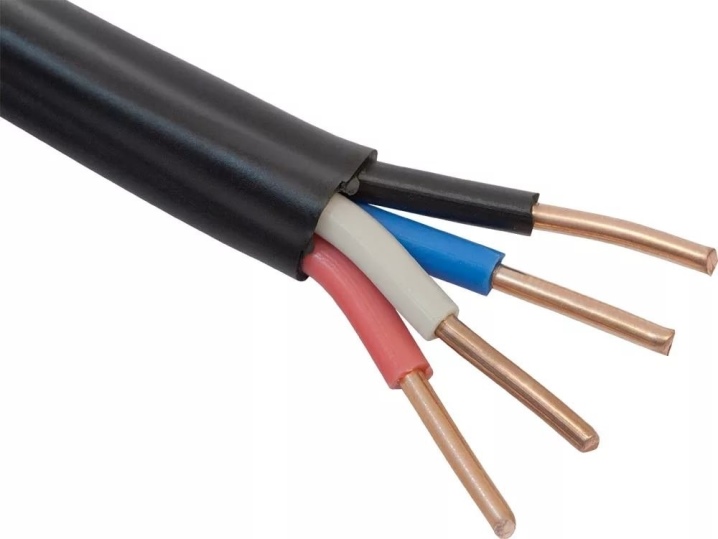
Copper tubing should be purchased from specialized stores. Pipes for air conditioning systems are made of extra soft copper and do not have seams. Some installers believe that plumbing products can be used. This is a misconception: the copper in such pipes is porous and brittle, and the surface is rough. This will not allow to ensure a reliable connection with the pipes, through the smallest cracks the freon will quickly evaporate.
You will need to purchase tubes of two diameters. For small systems, 1/4 ", 1/2" and 3/4 "sizes are standard. The required size is given in the instructions for the split system, and is also indicated on the case of the outdoor unit. Like the wire, the tubes must be purchased with a margin of 1-1.5 m.
After the store has measured out the required number of pipes, immediately close their ends tightly (for example, with tape). The air conditioner is very sensitive to dirt that can get inside the pipes during transportation. Do not remove the plugs during long-term storage. This will protect the system from moisture build-up inside.
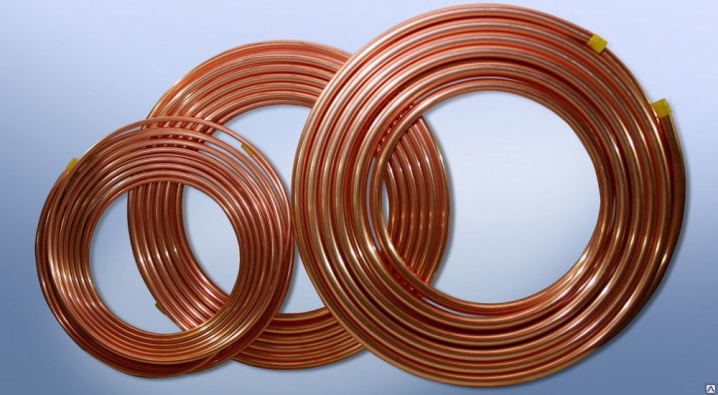
Thermal insulation is sold in the same place as special copper pipes. It is inexpensive, and you can also take it with some margin. Thermal insulation is sold in standard pieces of 2 m. Do not forget that you need it twice as much as the length of the track + 1 piece.
During installation, the ends of the insulation will be secured to the copper pipes with strong adhesive tape. Construction reinforced tape is well suited for this. In extreme cases, you can even do with electrical tape, but it should be borne in mind that it should not unstick over time. It is also convenient to use plastic mounting ties with a lock for fastening.
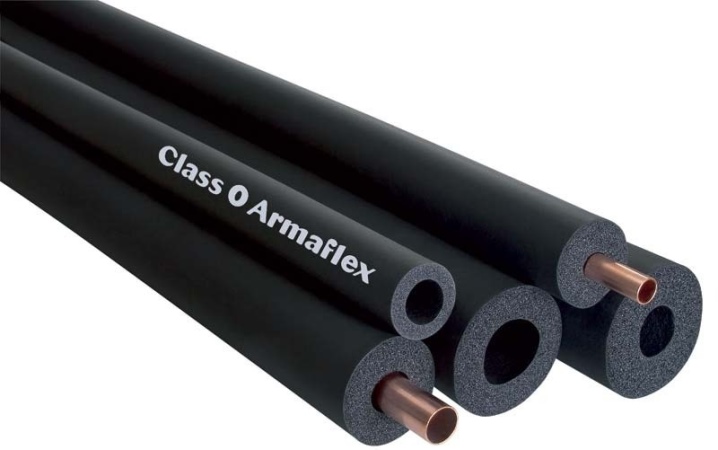
To drain the condensate, use plastic flexible tubes of a special design. For so that when laying the highway, they do not crumple when cornering, inside such pipes there is a thin but rigid steel spiral... They are sold in the same stores of spare parts and materials for air conditioning systems. Take such a tube with a margin of 1.5-2 m.
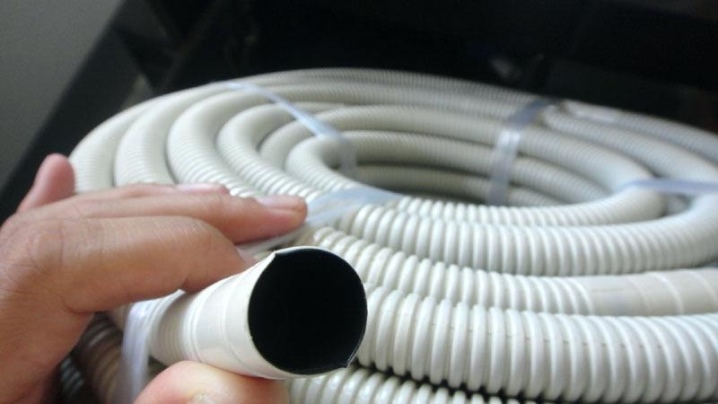
So that pipes and wires do not spoil the appearance, it is advisable to put them in a neat box. Standard electrical cable ducts with a cover are perfect for this. Such boxes are sold in 2 m segments. To make the track look neat, do not forget to purchase varietal products in addition to them: internal and external turning corners. For the installation of split systems, cable channels with a cross section of 80x60 mm are usually well suited.


The brackets, on which the external block of the split system will be installed from the outside, are L-shaped. The air conditioners are quite heavy and vibrate during operation. Therefore, it is necessary to purchase special brackets for installing air conditioners. Such products have high strength and rigidity. It is good if such brackets are included in the installation kit of your system, because ordinary building corners are not suitable for this purpose.
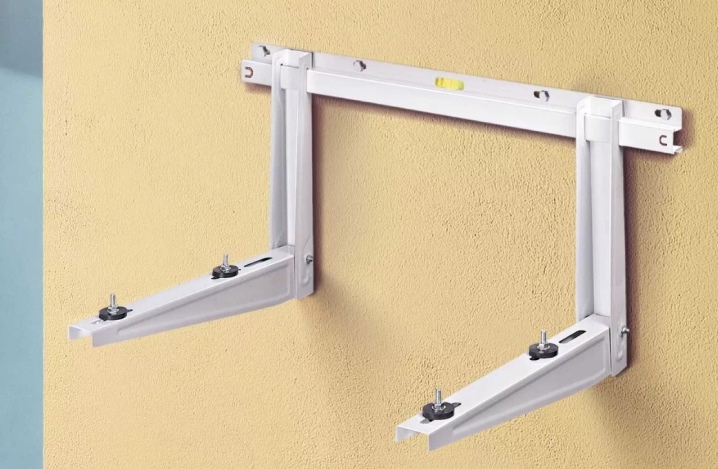
Anchors and dowels are required to fix the boxes, indoor unit frames and outdoor unit brackets to the walls. Screws and rubber washers are required to fix the outdoor unit to the mounting brackets. The required number of fasteners should be calculated in advance and a margin of 25-35% should be provided.

If you decide to install a split system with your own hands, you probably already have the following tools in your house:
- screwdrivers;
- building level;
- hex keys;
- drill and drill set;
- puncher.
A hammer drill is required not only for drilling small-diameter holes for dowels and anchors. You will also have to make several large-diameter holes in thick walls.
Not everyone has a heavy duty drill with diamond core bits at home. You can rent such a tool or hire a specialist to drill these few holes.
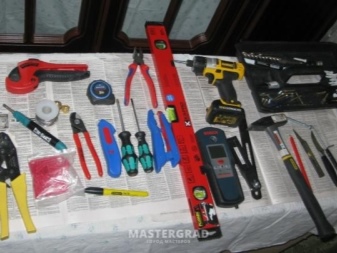

In addition, during the installation of the split system, you will need a special tool:
- a pipe cutter with a sharp blade;
- trimmer;
- flaring;
- pipe bender;
- gauge manifold;
- Vacuum pump.
It is too expensive to acquire such specialized equipment for the sake of one installation. But you can rent these unusual devices from a specialized company or from a familiar craftsman.
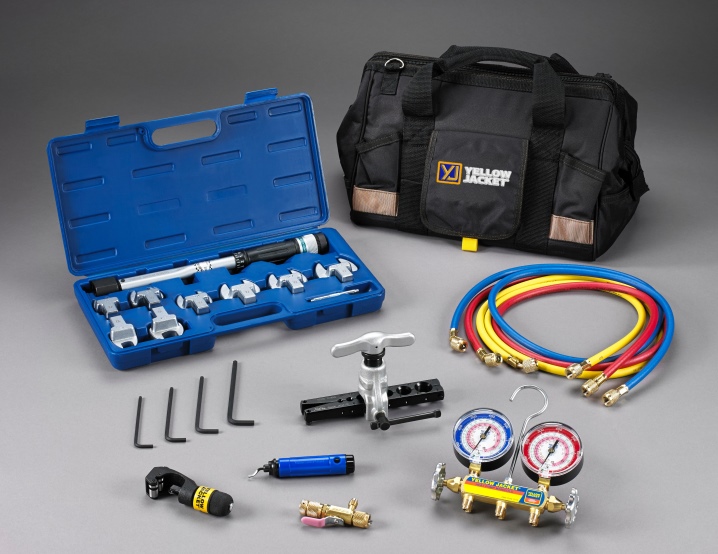
Installation procedure
In order to correctly and efficiently install a split system with your own hands, you need to do it in this order:
- you need to install the internal hardware first;
- then prepare communication channels;
- lay connecting lines in the channels;
- put an external block;
- connect blocks with electric and gas mains;
- evacuate the system and check its tightness;
- fill the system with refrigerant (freon).
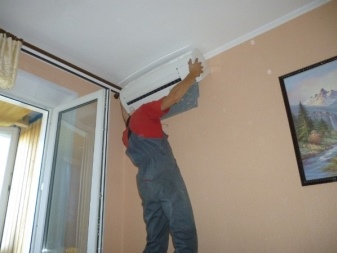

Internal equipment
The indoor unit is fixed to the wall using the supplied steel frame. Usually there is a drawing in the instructions, which indicates the location of the holes on the supporting surface of the wall. But it's easier to take the frame itself and mark the attachment points to the wall directly along it.
Take the mounting frame and place it on the wall where you plan to install the indoor unit. Make sure that the frame is perfectly horizontal using a spirit level. If the frame is tilted to the left or right, moisture inside the air conditioner may accumulate at one end and not reach the condensate drain.
After making sure the frame is horizontal, use it as a template to mark the wall. Using a puncher, make holes of the required diameter in the wall according to the marks. Fasten the base frame to the wall with dowels, screws or screws.
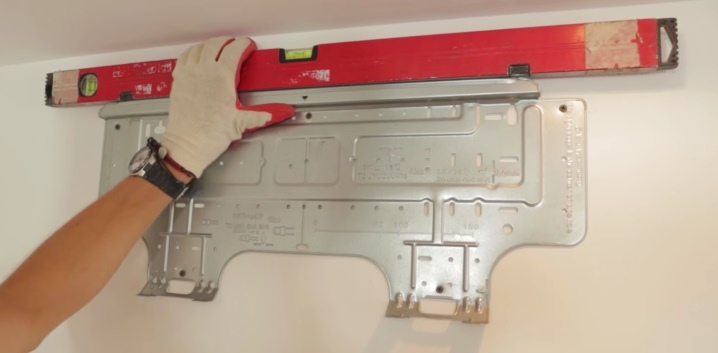
After the supporting frame is fixed, you need to prepare the channels through which the connecting lines will pass. First, mark a line on the wall along which the communications should pass. Among other things, there will be a drainage tube. In order for the water to drain freely onto the street, the line of the mains must have a slight slope, which is checked by the building level.
You can deepen the lines into the wall. To do this, using a chasing cutter, you will have to make channels 35-40 mm deep and 50-75 mm wide. This is bad because if you need to repair the air conditioner, you will have to ruin the wall.
It is easier to lay the lines in a plastic box. A standard cable channel with a cross section of 60x80 mm is well suited. Plastic boxes are attached to the wall with screws or dowels. Sometimes cable ducts are attached to concrete with construction glue, but this is not suitable for installing air conditioning systems.The fact is that copper lines and electrical wires are quite heavy.
In the outer wall of the room, you will have to make a deep hole with a diameter of 75-105 mm. Only a heavy construction rotary hammer can handle this. In order not to invite a specialist, you can make three holes with a diameter of 35-40 mm with your own hands with a simple puncher.
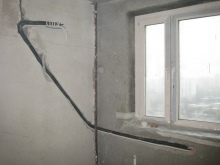
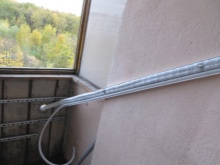

Outdoor module
It is quite difficult to install the external part of the split system on your own. The outdoor module is heavy and large. The matter is complicated by the fact that the work will have to be carried out outside the premises, moreover, at a considerable height.
First, prepare one hole for the top mounting of one of the brackets. Fix the top of the bracket and, placing it strictly vertically, mark the place of the lower attachment. After one bracket is fixed, you can mark the place for the second.
It is difficult and dangerous to do it on your own. Be sure to invite a helper to hold you. If possible, make insurance by securing it for special anchors.
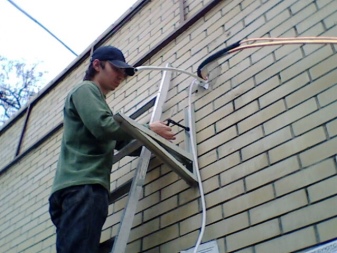
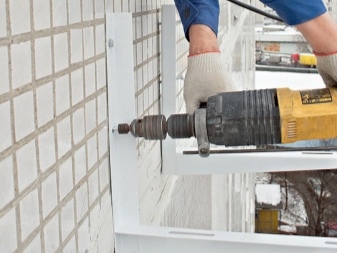
Using a building level, make a mark on the wall so that the second bracket is at the required distance from the first at exactly the same level. Fasten it in the same way as the first one.
The most difficult thing is to install the outdoor unit on the brackets. Due to the fact that there is a compressor inside it, the outdoor unit can weigh up to 20 kg. Just in case, tie the module with strong tape or rope and do not remove this insurance until you have fully secured the module to the brackets.
It is better to fix the outdoor unit through rubber gaskets. This will not only reduce noise in the house, but also extend the life of the air conditioner itself.
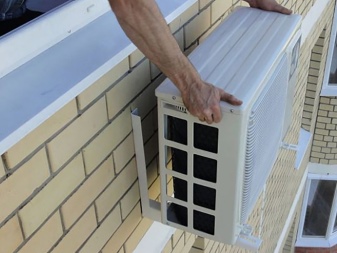
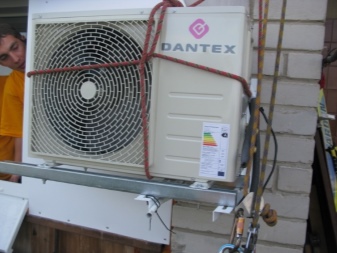
Connecting blocks
After the indoor and outdoor modules are installed and carefully fixed, they must be correctly connected to each other. Between the blocks will be laid:
- electric wires;
- copper lines (in thermal insulation);
- drainage tube.
It is necessary to carefully measure the length of the actual resulting route, cut off the cable and tubes. We cut off the electrical cable with a certain margin. Quite enough 25-35 cm. For the tube, we provide a margin of about 1 meter.
It is believed that pipes can be carefully cut with a fine-toothed hacksaw, but this is not the case. After the hacksaw, small burrs will remain, which are very difficult to smooth out. The pipe can only be cut correctly with a special tool (pipe cutter).

It is best to install the end nuts on the copper pipes indoors before placing them in the mains. To do this, we need special tools: a rimmer and flaring.
- Using a rimmer, carefully remove burrs from the inside and outside of the tube. It is especially important that the inner edge is very flat.
- Put on the end nut.
- Fix the tube in the rolling so that the edge protrudes above the rolling jaws by 1.5-2 mm. Clamp the tube so tightly that it does not move and under no circumstances begin to shrink.
- Having brought the cone to the tube cut, begin to press it into the tube with smooth movements. The effort will gradually increase.
- Twist the cone as far as it will go. This may require considerable effort.
- Having disassembled the tool, check the quality of the resulting "collar". A properly executed funnel has neat edges without cracks or chipping. The shiny rim of the funnel cone must have the same width.
Remember to put the nut on the tube first. It can be a shame to make a very neat edge, and then remember that they forgot to put on the nut. Then you have to cut off the edge and start all over again.
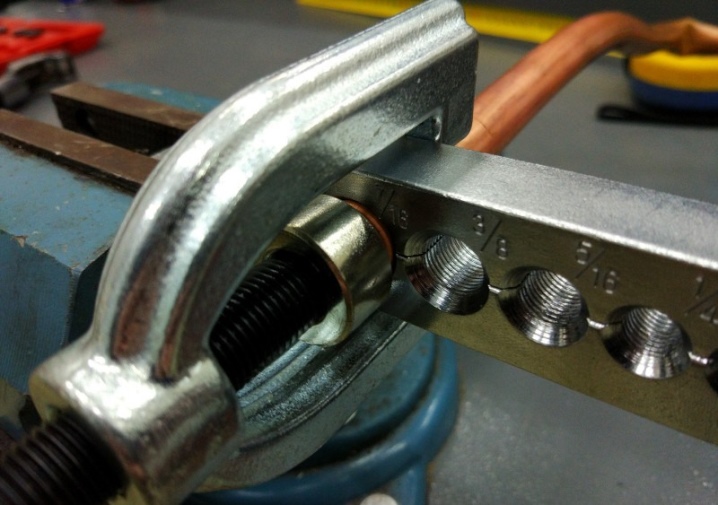
Correct pruning and neat rolling requires dexterity and skill. Inexperience can ruin the ends, so be sure to practice on trimming the tubes.
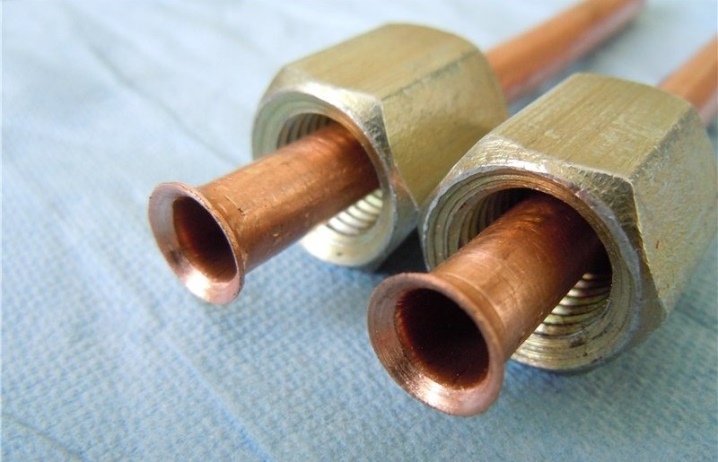
Now you can put the tubes in the line. Thermal insulation is preliminarily put on the tubes and fixed with tape. Observe the following rules when laying copper lines:
- bends should be smooth;
- bending radius - at least 10 cm;
- you cannot bend and straighten the tube several times;
- if the difference in the installation height of the units exceeds 5 m, the tube should be rolled into a ring at the bottom of the tube. Oil will be trapped in it.
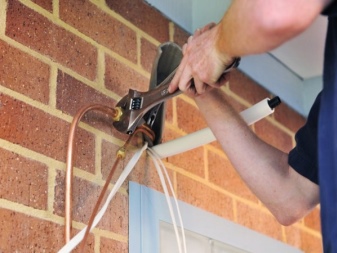
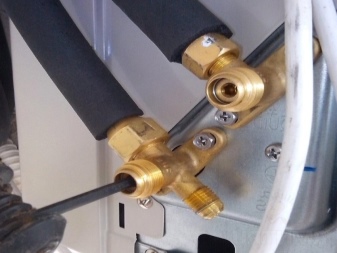
The set of the split system includes a wiring diagram. Correctly connecting the necessary contacts will help the fact that each core of the cable has its own color. Please note that the color of the cores of your wire may not match the color shown in the diagram. The main thing is that the contacts of the indoor and outdoor modules are connected in the correct order.
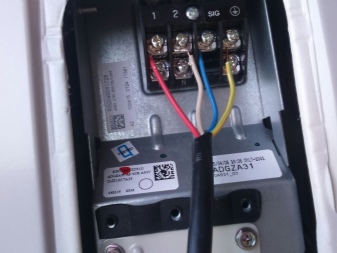
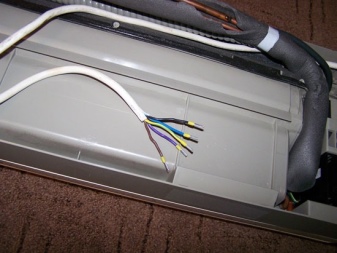
The drain tube is routed so that a slight, constant outward slope is ensured. From the outside, the free end of the drainage tube is attached to the wall with clamps so that it does not dangle and dripping condensation does not fall directly onto the wall.
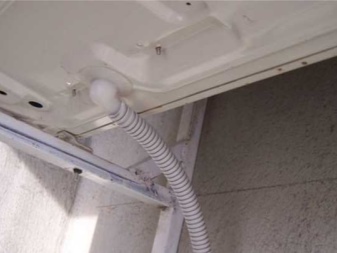
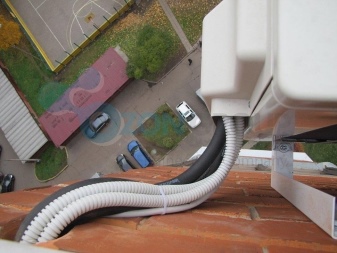
The copper pipes of the lines to the indoor and outdoor units are also connected according to the diagram. The end nuts must be tightened with a force of 5-7 kg * m. Then the copper of the tube will crimp well and flow into the smallest irregularities of the nipple. This will ensure complete tightness of the connection.
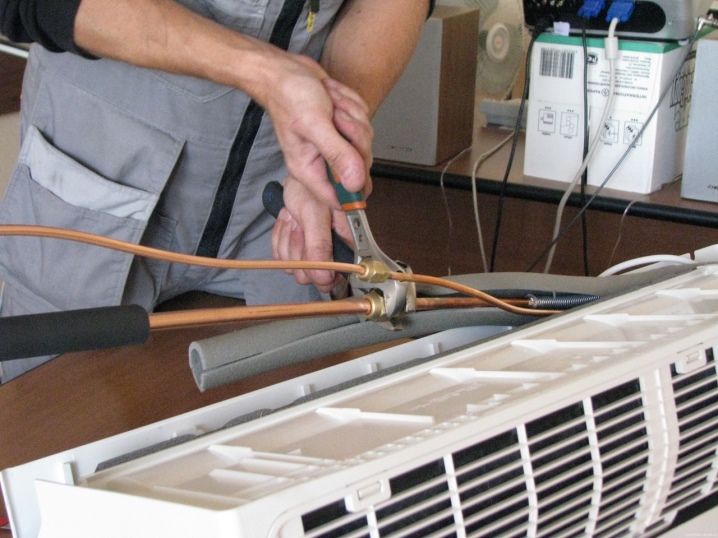
Evacuation
Evacuation is necessary in order to remove the remnants of moist air from the laid route. If this is not done, the refrigerant (freon) will be diluted, which will reduce its heat capacity. Moisture during the operation of the system can freeze, as a result, an expensive system will fail.
To perform this operation, you will need a gauge manifold, hex keys, a special pump to create a vacuum. The sequence of actions is as follows:
- connect the gauge manifold to the service port of the outdoor unit with a special hose;
- connect the vacuum pump with another hose through the collector unit;
- without opening the ports, turn on the pump;
- open the tap on the gauge manifold under the gauge.
Only in this way the air from the line will begin to be pumped out.
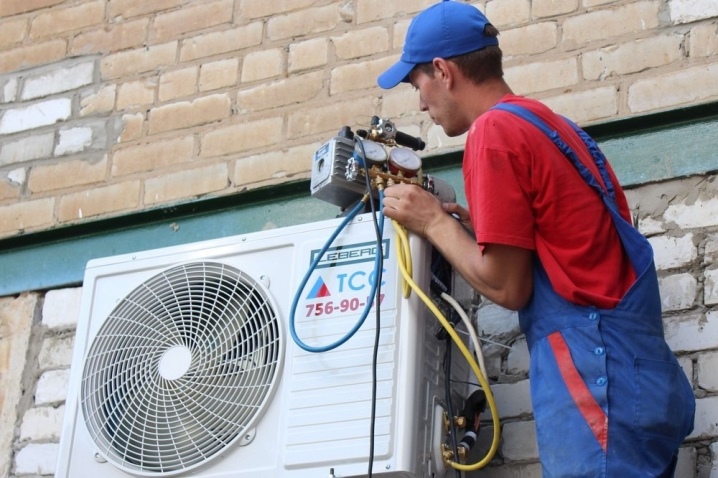
The pressure gauge needle will gradually lower to indicate the degree of air evacuation. Even after the arrow has stopped, it is not worth turning off the pump. Let the pump run for about 30 minutes. This will allow any remaining moisture to evaporate and be removed by the pump.
Before turning off the pump, do not forget to turn off the tap on the gauge manifold. But do not disconnect the pump yet. Observe the indicator hand for 20 minutes. If the readings do not change, we can assume that the line is tight.
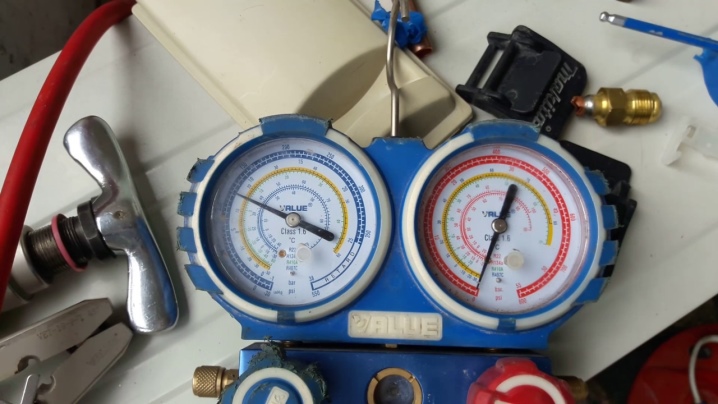
Do not turn off the pump. Use a hex key to open the lower (gas) port on the outdoor unit. After the noise in the line subsides, unscrew the pump hose as soon as possible.
There is usually a certain amount of Freon in the outdoor unit of the system you just purchased. It is enough to fill a short (up to 4-5 meters long) line. Smoothly open the upper (liquid) port with a hexagon, and the freon will fill the line.
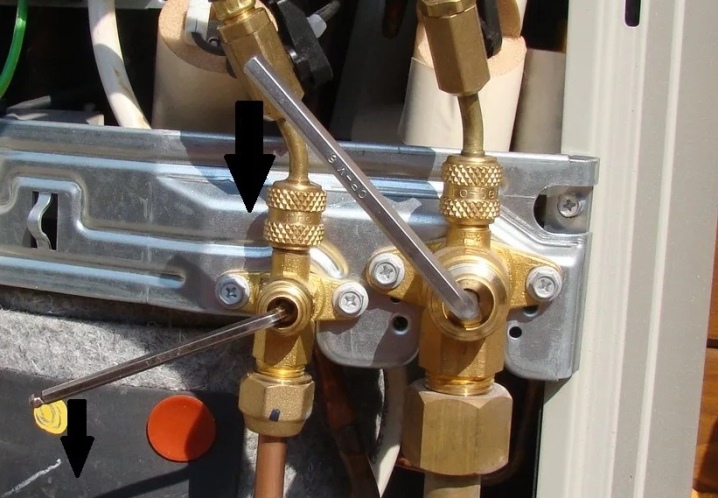
If the split system has already been repaired or the line is longer than 4 m, additional refueling required.
- Connect the container with freon to the gauge manifold. Open the upper port on the air conditioner unit smoothly.
- Open the valve on the manifold module. Wait until the pressure gauge shows that the line is filled to the pressure recommended by the manufacturer in the instructions.
- Close the valve on the manifold.
- Quickly disconnect the manifold hose from the service nipple.
When you disconnect the hose, a little freon will escape from the nipple, which in the air will become scaldingly cold. Perform all work only with thread gloves.
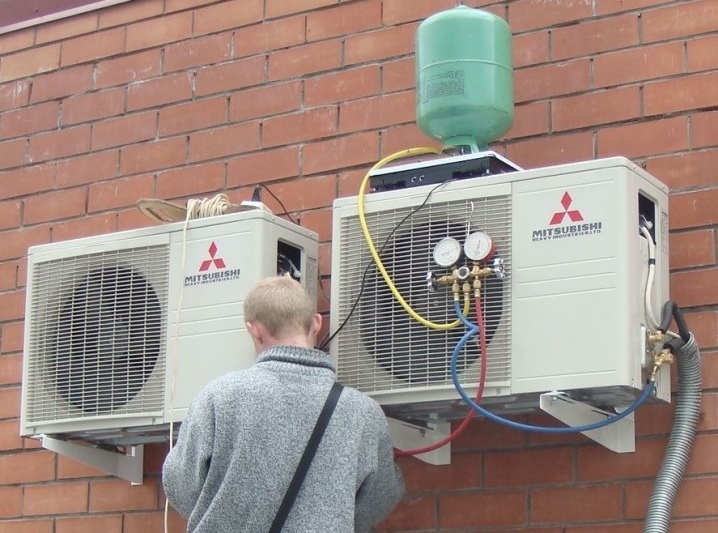
Common mistakes
Most often, when installing a split system with their own hands, users make the following mistakes:
- place the outdoor unit on a closed balcony;
- sharp bends of the main pipes;
- lay the drainage tube without a slope or with loops and slides;
- the ends of the main pipes are not neatly flared;
- the connecting nuts of the lines are loose.
It is completely useless to place an external block of a split-system in a closed room. The outdoor unit will heat the loggia to the maximum temperature that the air conditioner is capable of. After that, there will be no coolness inside the apartment.
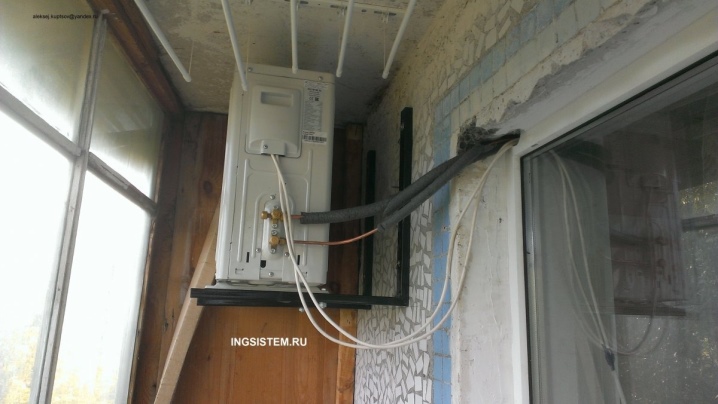
Sharp bends in the line increase the load on the compressor. The air conditioner is noisier and the service life is reduced. This will also reduce the efficiency of the entire system and the air conditioner will stop doing its job.
If the drain line is not laid neatly, water will not flow freely into the street. Instead, it will accumulate in the tray of the indoor unit and gradually begin to seep directly into the apartment.
If the rolling is not done properly or the nuts are not tightened tightly enough, the refrigerant will gradually evaporate. The air conditioner will gradually stop producing cold and will need to be refilled with freon. If the defects in the connections are not corrected, the split system will have to be constantly charged with refrigerant.
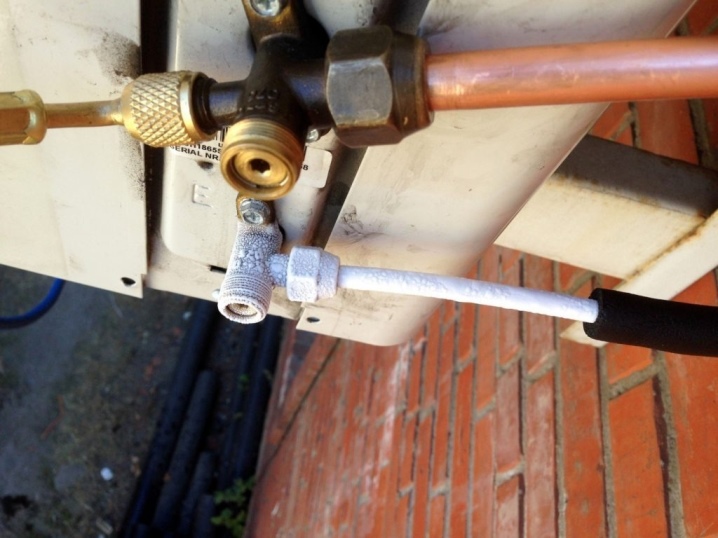
Next, watch a video with tips for installing a split system yourself.













Thanks!
The comment was sent successfully.